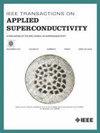Measurable Improvement in Multi-Qubit Readout Using a Kinetic Inductance Traveling Wave Parametric Amplifier
IF 1.7
3区 物理与天体物理
Q3 ENGINEERING, ELECTRICAL & ELECTRONIC
引用次数: 0
Abstract
Increasing the size and complexity of quantum information systems requires highly-multiplexed readout architectures, as well as amplifier chains operating near the quantum limit (QL) of added noise. While documented prior efforts in KI-TWPA integration in quantum systems are scarce, in this work we demonstrate integration of a KI-TWPA with a multiplexed-qubit device. To quantify the system noise improvement we perform an ac Stark shift calibration to precisely determine noise power levels on-chip (at each cavity's reference plane) and the total system gain. We then characterize the qubit state measurement fidelity and the corresponding signal-to-noise ratio (SNR). To conduct the most faithful measurement of the benefits offered by the KI-TWPA we perform these measurements for readout chains where the high electron mobility transistor (HEMT) amplifier is the first-stage amplifier (FSA) – with none of the external hardware required to operate the KI-TWPA – and with the KI-TWPA as the FSA. While some readout cavities fall outside the KI-TWPA bandwidth, for those inside the bandwidth we demonstrate a maximum improvement in the state measurement SNR by a factor of 1.45, and increase the fidelity from 96.2% to 97.8%. These measurements demonstrate a system noise below 5 quanta动态电感行波参量放大器对多量子位读出性能的显著改善
增加量子信息系统的大小和复杂性需要高度复用的读出架构,以及在添加噪声的量子极限(QL)附近工作的放大器链。虽然之前在量子系统中KI-TWPA集成方面的文献很少,但在这项工作中,我们展示了KI-TWPA与多路量子比特设备的集成。为了量化系统噪声的改善,我们进行了交流斯塔克移位校准,以精确地确定芯片上(在每个腔的参考平面上)的噪声功率水平和系统总增益。然后,我们描述了量子位态测量保真度和相应的信噪比(SNR)。为了对KI-TWPA提供的好处进行最忠实的测量,我们对读出链进行了这些测量,其中高电子迁移率晶体管(HEMT)放大器是第一级放大器(FSA) -不需要任何外部硬件来操作KI-TWPA -并将KI-TWPA作为FSA。虽然一些读出腔落在KI-TWPA带宽之外,但对于那些在带宽内的读出腔,我们展示了将状态测量信噪比提高1.45倍的最大改进,并将保真度从96.2%提高到97.8%。这些测量表明,在片上参考的系统噪声低于5个量子,并且我们将KI-TWPA带宽内的六个腔的多余噪声限制在4个量子以下。这些结果显示了在使用单参数放大器的大量子位系统中实现量子限制读出链的有前途的途径。
本文章由计算机程序翻译,如有差异,请以英文原文为准。
求助全文
约1分钟内获得全文
求助全文
来源期刊

IEEE Transactions on Applied Superconductivity
工程技术-工程:电子与电气
CiteScore
3.50
自引率
33.30%
发文量
650
审稿时长
2.3 months
期刊介绍:
IEEE Transactions on Applied Superconductivity (TAS) contains articles on the applications of superconductivity and other relevant technology. Electronic applications include analog and digital circuits employing thin films and active devices such as Josephson junctions. Large scale applications include magnets for power applications such as motors and generators, for magnetic resonance, for accelerators, and cable applications such as power transmission.
 求助内容:
求助内容: 应助结果提醒方式:
应助结果提醒方式:


